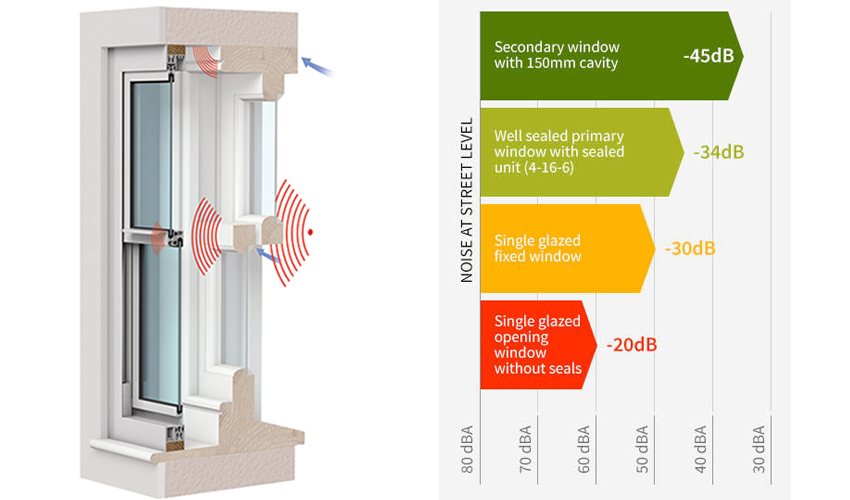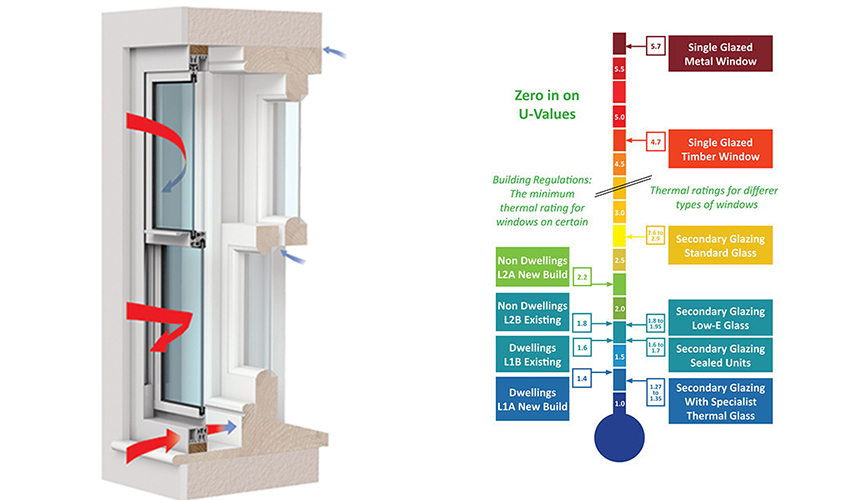Some people say that the standard of the education is down to the teacher’s skills and somewhat of the individual; others will place more emphasis on the resources of the school. But what about the building itself – does that not have just as an important part to play?
There are over 5,000 Listed school buildings in the UK, which have had to be adapted over time to reflect changes in teaching styles. More complex laboratories have been introduced, highly sophisticated computer rooms, state of the art drama centres and music rooms; which often are not supported fully by the fabric of the building. This can lead to an uncomfortable environment for the users, which hinders concentration and learning capabilities.
The causes can be; noise ingress and egress which causes distractions for pupils and teaching staff alike, uncomfortable draughts and loss of heating, as well as security breaches in laboratories or IT centres. By adding secondary glazing to targeted areas of an old educational building, it can help see immediate improvements in each of these problem areas.
Single glazed windows offer on average a 20dB reduction of sound, so if in an area or classroom overlooking a playground or a ‘noisy space’ then there are likely to be many distractions for the occupiers. In the case of a music room, there is need to stop the noise escaping from the room causing a nuisance to others. Therefore, if the building has single glazed windows and is Listed, acoustic secondary glazing would be an acceptable adaptation to help lift the performance to required standards. If a cavity of 150mm is created glass to glass between the primary and secondary windows, then a reduction of up to 45-50dB can be achieved, which is more than double glazing alone.
 Acoustic secondary glazing with – 45dB sound reduction
For further information pertaining to school acoustics, the document Building Bulletin 93 (February 2015) - Acoustic design of schools: performance standards; sets out principles and guidelines for construction of a new-build educational facility, as well as guidelines on undertaking a refurbishment. In addition, the World Health Organisation has also set out acceptable noise level ratings which apply to schools.
By introducing well sealed secondary glazing, air gaps that let unwanted draughts in are virtually eliminated and heat retention is improved. With low-E glazing, a U-value of 1.9 can be achieved. This, in turn, should see a reduction in energy bills.
Acoustic secondary glazing with – 45dB sound reduction
For further information pertaining to school acoustics, the document Building Bulletin 93 (February 2015) - Acoustic design of schools: performance standards; sets out principles and guidelines for construction of a new-build educational facility, as well as guidelines on undertaking a refurbishment. In addition, the World Health Organisation has also set out acceptable noise level ratings which apply to schools.
By introducing well sealed secondary glazing, air gaps that let unwanted draughts in are virtually eliminated and heat retention is improved. With low-E glazing, a U-value of 1.9 can be achieved. This, in turn, should see a reduction in energy bills.
 Thermal secondary glazing with a U-Value of 1.9
Building Regulation Part L looks at the conservation of fuel and power and sets strict standards of energy efficiency for new buildings, renovations and upgrades. Secondary glazing is not covered by Part L except for use in heritage buildings where projects come under building control regulations.
Duty of care for students and staff is also high on the agenda in education. With regards to the fabric of the building, it means ensuring sensitive areas, rooms and information are protected, safeguarding the people within. It could be a simple secure reception area at the entrance to a school in a vulnerable area, or heavy duty high security viewing panels into a containment level 2 or 3 research laboratory – which need to be robust to stop the outbreak of any leakages and create a pleasant atmosphere for the researchers to work in. Guidelines on the construction and requirements of these have been set out by the Governments Health and Safety Executive. Secondary glazed security fixed panels are a solution to these problems and as a retrofit solution, can be installed quickly and make the rooms fit for purpose.
If the educational establishment is well insulated, with a peaceful calming interior, then it is more than likely you will see an improvement in the student’s learning capacity and make their time at school more memorable for the right happy reasons!
Thermal secondary glazing with a U-Value of 1.9
Building Regulation Part L looks at the conservation of fuel and power and sets strict standards of energy efficiency for new buildings, renovations and upgrades. Secondary glazing is not covered by Part L except for use in heritage buildings where projects come under building control regulations.
Duty of care for students and staff is also high on the agenda in education. With regards to the fabric of the building, it means ensuring sensitive areas, rooms and information are protected, safeguarding the people within. It could be a simple secure reception area at the entrance to a school in a vulnerable area, or heavy duty high security viewing panels into a containment level 2 or 3 research laboratory – which need to be robust to stop the outbreak of any leakages and create a pleasant atmosphere for the researchers to work in. Guidelines on the construction and requirements of these have been set out by the Governments Health and Safety Executive. Secondary glazed security fixed panels are a solution to these problems and as a retrofit solution, can be installed quickly and make the rooms fit for purpose.
If the educational establishment is well insulated, with a peaceful calming interior, then it is more than likely you will see an improvement in the student’s learning capacity and make their time at school more memorable for the right happy reasons!
 Acoustic secondary glazing with – 45dB sound reduction
For further information pertaining to school acoustics, the document Building Bulletin 93 (February 2015) - Acoustic design of schools: performance standards; sets out principles and guidelines for construction of a new-build educational facility, as well as guidelines on undertaking a refurbishment. In addition, the World Health Organisation has also set out acceptable noise level ratings which apply to schools.
By introducing well sealed secondary glazing, air gaps that let unwanted draughts in are virtually eliminated and heat retention is improved. With low-E glazing, a U-value of 1.9 can be achieved. This, in turn, should see a reduction in energy bills.
Acoustic secondary glazing with – 45dB sound reduction
For further information pertaining to school acoustics, the document Building Bulletin 93 (February 2015) - Acoustic design of schools: performance standards; sets out principles and guidelines for construction of a new-build educational facility, as well as guidelines on undertaking a refurbishment. In addition, the World Health Organisation has also set out acceptable noise level ratings which apply to schools.
By introducing well sealed secondary glazing, air gaps that let unwanted draughts in are virtually eliminated and heat retention is improved. With low-E glazing, a U-value of 1.9 can be achieved. This, in turn, should see a reduction in energy bills.
 Thermal secondary glazing with a U-Value of 1.9
Building Regulation Part L looks at the conservation of fuel and power and sets strict standards of energy efficiency for new buildings, renovations and upgrades. Secondary glazing is not covered by Part L except for use in heritage buildings where projects come under building control regulations.
Duty of care for students and staff is also high on the agenda in education. With regards to the fabric of the building, it means ensuring sensitive areas, rooms and information are protected, safeguarding the people within. It could be a simple secure reception area at the entrance to a school in a vulnerable area, or heavy duty high security viewing panels into a containment level 2 or 3 research laboratory – which need to be robust to stop the outbreak of any leakages and create a pleasant atmosphere for the researchers to work in. Guidelines on the construction and requirements of these have been set out by the Governments Health and Safety Executive. Secondary glazed security fixed panels are a solution to these problems and as a retrofit solution, can be installed quickly and make the rooms fit for purpose.
If the educational establishment is well insulated, with a peaceful calming interior, then it is more than likely you will see an improvement in the student’s learning capacity and make their time at school more memorable for the right happy reasons!
Thermal secondary glazing with a U-Value of 1.9
Building Regulation Part L looks at the conservation of fuel and power and sets strict standards of energy efficiency for new buildings, renovations and upgrades. Secondary glazing is not covered by Part L except for use in heritage buildings where projects come under building control regulations.
Duty of care for students and staff is also high on the agenda in education. With regards to the fabric of the building, it means ensuring sensitive areas, rooms and information are protected, safeguarding the people within. It could be a simple secure reception area at the entrance to a school in a vulnerable area, or heavy duty high security viewing panels into a containment level 2 or 3 research laboratory – which need to be robust to stop the outbreak of any leakages and create a pleasant atmosphere for the researchers to work in. Guidelines on the construction and requirements of these have been set out by the Governments Health and Safety Executive. Secondary glazed security fixed panels are a solution to these problems and as a retrofit solution, can be installed quickly and make the rooms fit for purpose.
If the educational establishment is well insulated, with a peaceful calming interior, then it is more than likely you will see an improvement in the student’s learning capacity and make their time at school more memorable for the right happy reasons!- Date
- Category
- Secondary Glazing in Practice